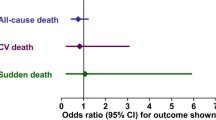Abstract
The effects of a recently described inhibitor of endothelial NO synthesis, N G-nitro-l-arginine (l-NNA), on the vasomotor responses to endothelium-dependent and independent vasodilators, and on the release of endothelium-derived relaxing factor (EDRF), were studied in the isolated saline-perfused rabbit heart. Infusion of l-NNA (30 μM) resulted in a 52±12% increase in basal coronary perfusion pressure. The vasomotor responses to 1 μM acetylcholine (ACh) and serotonin after l-NNA became biphasic, showing a small transient dilation followed by a pronounced vasoconstriction. In contrast, the dilation observed with sodium nitroprusside was not affected by l-NNA. None of the above-mentioned effects was elicited by the Stereo-isomer d-NNA. Similarly, an increase in the basal coronary perfusion pressure by endothelin-1 (0.3 nM) to the same level as observed with l-NNA did not alter the vasomotor responses to ACh and sodium nitroprusside. The increase in cyclic GMP (cGMP) in platelets passing through the coronary vascular bed was used as an index of EDRF release. Platelet cGMP amounted to 0.50±0.10 pmol/mg protein after passage through the coronary bed of the unstimulated heart. When platelets were injected during an ACh infusion (1 μM), a 2.7 fold increase in cGMP was observed (P<0.01). After a 30-min infusion with l-NNA, the cGMP content of platelets passing through the unstimulated heart was reduced by 62%. Likewise, the ACh-induced increase in platelet cGMP was totally blocked. These results show that l-NNA inhibits EDRF release, and is thus a potent and selective inhibitor of EDRF-mediated dilation in the isolated rabbit heart.
Similar content being viewed by others
References
Amezcua JL, Palmer RMJ, de Souza BM, Moncada S (1989) Nitric oxide synthesized from l-arginine regulates vascular tone in the coronary circulation of the rabbit. Br J Pharmacol 97:1119–1124
Böhme E, Jung R, Mechler I (1974) Guanylate cyclase in human platelets. Methods Enzymol 38:199–202
DeMey JG, Vanhoutte PM (1983) Anoxia and endothelium-dependent reactivity of the canine femoral artery. J Physiol (Lond) 335:65–74
Feletou M, Vanhoutte PM (1988) Endothelium-dependent hyperpolarization of canine coronary smooth muscle. Br J Pharmacol 93:515–524
Furchgott RF (1983) The role of endothelium in responses of vascular smooth muscle. Circ Res 53:557–573
Furchgott RF (1988) Studies on the relaxation of rabbit aorta by sodium nitrite: the basis for the proposal that, the acidactivatable inhibitory factor from bovine retractor penis is inorganic nitrite and the endothelium-derived relaxing factor is nitric oxide. In: Vanhoutte PM (ed) Vasodilatation, vol 4. Raven, New York, pp 401–414
Huang AH, Busse R, Bassenge E (1988) Endothelium-dependent hyperpolarization of smooth muscle cells in rabbit femoral arteries is not mediated by EDRF (nitric oxide). Naunyn-Schmiedeberg's Arch Pharmacol 338:438–442
Kelm M, Schrader J. (1988) Nitric oxide release from the isolated guinea pig heart. Eur J Pharmacol 155:313–316
Kelm M, Schrader J (1990) Control of coronary vascular tone by nitric oxide. Circ Res 66:1561–1575
Lowry OH, Rosebrough NJ, Farr AL, Randall RJ (1951) Protein measurement with the Folin phenol reagent. J Biol Chem 193:265–275
Mülsch A, Busse R (1990) N G-nitro-l-arginine (N5-[imino(nitroamino)methyl]-l-ornithine) impairs endothelium-dependent dilations by inhibiting cytosolic nitric oxide synthesis from l-arginine. Naunyn-Schmiedeberg's Arch Pharmacol 341:143–147
Palmer RMJ, Ferrige AG, Moncada S (1987) Nitric oxide release accounts for the biological activity of endothelium-derived relaxing factor. Nature 327:524–526
Palmer RMJ, Rees DD, Ashton DS, Moncada S (1988) l-Arginine is the physiological precursor for the formation of nitric oxide in endothelium-dependent relaxation. Biochem Biophys Res Commun 153:1251–1256
Pohl U, Busse R (1989a) EDRF increases cyclic GMP in platelets during passage through the coronary vascular bed. Circ Res 65:1798–1803
Pohl U, Busse R (1989b) Hypoxia stimulates release of endotheliumderived relaxant factor. Am J Physiol 256: H1595-H1600
Stewart DJ, Münzel T, Bassenge E (1987) Reversal of acetylcholine-induced coronary resistance vessel dilation by hemoglobin. Eur J Pharmacol 136:239–242
Author information
Authors and Affiliations
Rights and permissions
About this article
Cite this article
Lamontagne, D., Pohl, U. & Busse, R. N G-nitro-l-arginine antagonizes endothelium-dependent dilator responses by inhibiting endothelium-derived relaxing factor release in the isolated rabbit heart. Pflügers Arch 418, 266–270 (1991). https://doi.org/10.1007/BF00370525
Received:
Revised:
Accepted:
Issue Date:
DOI: https://doi.org/10.1007/BF00370525




